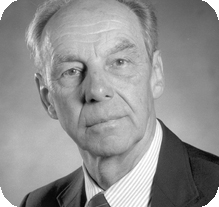
Juris Hartmanis

Hierarchy of Complexity Classes
This hierarchy states that for any suitable counting function T (and all natural functions are suitable), as long as T0 is somewhat bigger than T (namely, that infinitely often T0 exceeds T2 and later improved by Hennie [1] so that infinitely often T0 exceeds T log T), there are sequences and sets that can be computed in time T0 but not time T. This worst case “infinitely often” type of analysis and idea of complexity classes (i.e. the class of functions, sets or sequences computable within time bound T) was adopted by Cook, Karp, and Levin in establishing the importance of the difference between P (deterministic polynomial time) and NP (non-deterministic polynomial time or what can be verified in polynomial time).
Oral interview
An oral interview (both transcript and audio recording) with Hartmanis can be found here.
Cornell University has also made available a 70-minute conversation with Hartmanis in their digital repository here.




























 THE A.M. TURING AWARD
THE A.M. TURING AWARD